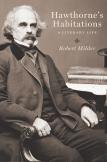The Scarlet Fretter
This new literary biography—”not a formal biography but more than a work of literary criticism,” in the words of its author, Robert Milder, professor of English at Washington University in St. Louis—contends that Nathaniel Hawthorne was a man divided be-tween his realist perceptions and his romantic aspirations. In his notebooks, Hawthorne wrote, according to Millicent Bell, as “a man for whom the world is exactly what it is and no more.” Milder asks, “Why should a realist, as in his apprehension of experience Haw-thorne visibly was, have written the nonrealistic tales and romances he did?”
Because, Milder says, Hawthorne feared what he saw as the naturalistic implications of the world he wrote about in his notebooks, he had to shape and mold this world into something that made both artistic sense and had moral purpose. Hawthorne believed in God, but did not accept any orthodox form of Christianity, so he did not have the assurance of faith to face reality. Ironically, Milder says, Harriet Beecher Stowe, a firmly committed Christian, could write more frankly about the dark underside of things within a realistic setting.
What did Hawthorne believe in?
A feeling of “human destiny”—of life unfolding according to universal laws consequent with traditional religion but not dependent on it—was what Hawthorne clung to in the absence of orthodox belief. Sin was his conduit to experiential meaning, to cosmic order, to God’s Providence, and to the immortality of the soul. Without the reality of sin, there was no transcendent dimension to human affairs, only the anarchic play of desire and circumstance he observed during his youthful travels and recorded in its immediacy with little sense of its bearing on any “great questions of life.”
Hawthorne’s real gift, according to Milder, was realism. Though his early fictions were powerful, especially stories like “Young Goodman Brown,” and novels, especially The Scarlet Letter, yet he shifted into realism with A Blithedale Romance. The title is inronic, since this is his most down-to-earth novel until at its end he contrives to romanticize the story to bring it into line with the ordered universe he wished to believe in.
Milder organizes the book upon the realist-romantic axis and at the same time shows how Hawthorne changed according to where he was living at the time, hence the title. Salem, where he was born and raised and served his almost monk-like apprenticeship, was the setting of his most powerful works. Trying to leave behind the darkness of Salem, he married and moved to Concord but lost some of his literary power. Then, serving as ambassador in Liverpool, England, he faced the unromantic realities of English poverty and materialism, and poured what he saw into his notebooks. Finally came Rome, where he found himself ambivalently attracted to parts of Catholicism, especially confession. The city served as the setting for his last novel, The Marble Faun.
This aspect of the book is the weakest. The time in Rome did not contribute much to the book’s theme and never came quite into focus. It grounded the book, so to speak, emphasized the biographical aspects as opposed to the purely literary ones of Hawthorne’s life, but the connection between place and ideas is not as strong as Milder contends. Wherever Hawthorne lived, he lived mostly in his head.
Nevertheless, Milder’s book is marvelously free of theoretical jargon (though the author had to quote some to provide critical context) and focuses on Hawthorne’s view of life and the art he created to both explore and wrestle with that view instead of trying to overlay a theory of some sort on it. Milder’s generous use of quotations from nonliterary figures—Plato, Freud and Nietzsche, for example—in addition to literary figures, like Melville, Henry James and Virginia Woolf, is quite effective, as are quotations from the seldom mentioned book on Hawthorne by his son, Julian.
In Hawthorne’s Habitations: A Literary Life, Robert Milder has written a book all Hawthorne scholars will have to read, one that will greatly reward anyone who has read and been haunted by Hawthorne’s works. It is the story of a writer divided between realism and romance, much as Gogol was, and who, toward the end of his life would perhaps had done better to give up romances for realistic novels and/or memoirs, something Milder convincingly argues. But except for that division, Hawthorne might never have written in the first place, nor with equal power.
This article also appeared in print, under the headline “The Scarlet Fretter,” in the May 13, 2013, issue.








